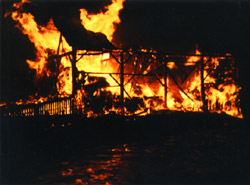|
Oh, the memories! The big barn with its tin roof and twin silos facing east brought the unexpected creak of walls or rafters, or the bawling calf. Rain sometimes stuttered, but more frequently drummed on and on while the gutters and drainpipes ran full to the nearby pond.
The 16’ x 16’ milk house of concrete blocks had a flat concrete ceiling that iced in cold weather until Dad placed insulating straw bales on the roof. Eventually, the straw decayed and weeds sprouted from seeds in the straw. The milk house had an inner screen door that wobbled when unhooked but it allowed the milk smell some travel space. The milk house had an antechamber and extra door as required by “dairy law,” supposedly to keep down the flies. And, oh those flies! They were everywhere and at all times. Big flies and horse flies too, although the horses were long gone. Kathleen remembers the December the equipment froze in the milk house when someone left the outer door open overnight. There was little under the Christmas tree that year.
The barn had two white concrete stave silos, a 10’ x 30’ eventually topped with ten additional feet and a second 12’ x 40’ silo. Chopped oat hay and sweet clover mixed with pungent smelling molasses was blown into them each year. That silage! Starting from the top of the silo, we would throw it down through interior doors, big scoops full, steaming, sometimes moldy, heavy and filled with molasses for those almighty Holsteins. After the barn was converted for sheltering pigs, the silos were connected one at a time by steel cables to tractors. The tractors pulled and reared on the back wheels until the two concrete companions grudging gave way, fell to the ground and imploded. In a few minutes the once dominant structures became a pile of gray concrete and twisted steel debris.
I remember when sturdy, dark-brown Bob and trusty, mottled Babe met their maker. They were ancient and about 1950 the time had come for the Co-Op tractor to replace them. Grandpa limped into the barn to get a burlap bag to cover their eyes. It was Dad’s task to aim the rifle and put a quick humane end to old age. The dead animal truck was already there and hand cranks pulled and loaded the two workhorses onto the bed for the trip to the fertilizer factory. There was no more riding Bob and Babe across the garden while the plow turned the moist black furrows and Grandpa provided the gear shifting and turn signals with a “giddy up, gee and haw.” The gas horse took over.
Oh, that barn, the big barn and “Dad’s barn,” as David said when he called me about the fire. “It’s gone, burned to the ground.”
A neighbor returning home after dark, saw a glow, suspected a chimney fire, took a detour, saw the corner of the barn in flames and called 911. He shouted to the unbelieving renters in the farmhouse who called Dave. With his four sons, a cousin, a nephew and three friends, Dave flew down the road to the barn and arrived before the fire trucks. Imagine the sensation, the adrenaline and the fear. It was 9:30 p.m. December 27, 1999.

December 27, 1999
|
“Open the gates! Get the 50 sows out!” They used the metal gates to corral the sows in the barnyard between the little barn and the corn crib, and distract them with cornmeal. Flames high, heat intense, hay burning like paper, no wind, a little snow, a frigid 14-degree temperature. Flames straight up, 40-50 feet above the 35-foot gable peak, an orange glow against the dark night seen for miles around. “No, you can’t pull the silage wagon to safety from the mow floor; no one knows when the tin roof will fall.” Three pigs run back to the warmth and soon are singed with fire, squealing to the end. The heat! The sounds! Almost subsumed by heat and light, the noise is singular. Like a tornado, big wind, sucking and popping, cracking and splintering — all rolled into one indescribable terrifying rage.
|

![]()
![]()

![]()
![]()